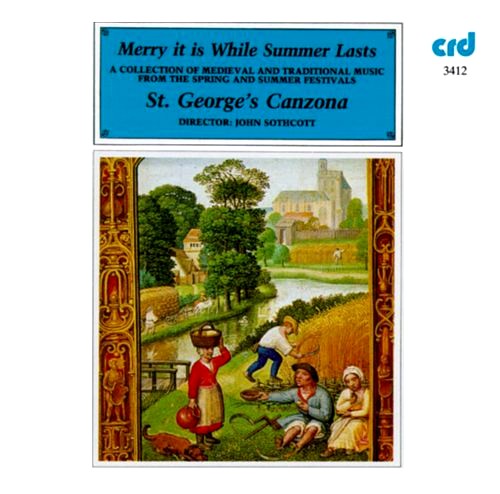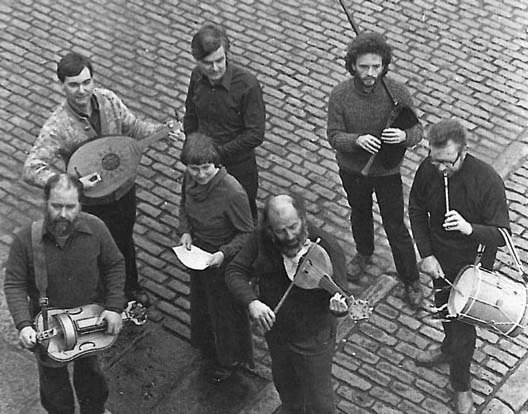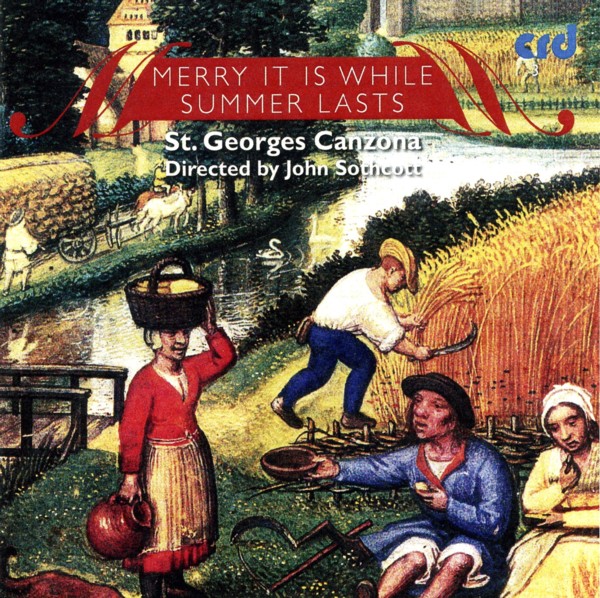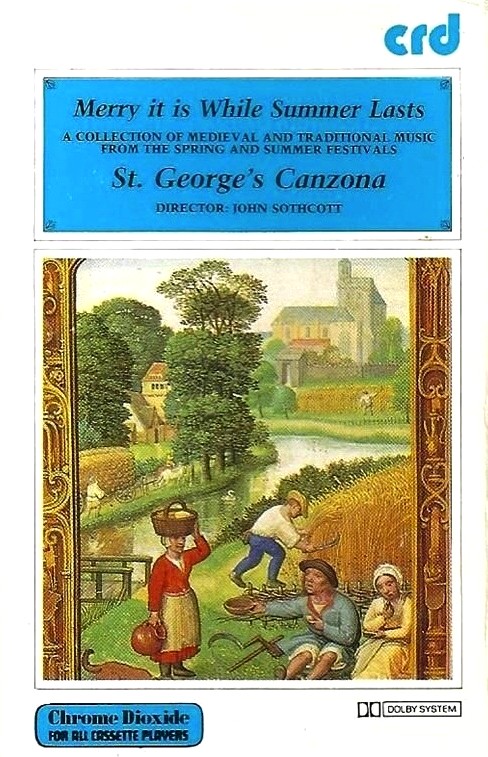Merry it is While Summer Last / St. Georges's Canzona
A collection of Medieval and Traditional music from the Spring and Summer Festivals

medieval.org
crd 1112 / crd 3412 /crd C 4112, 1983
crd 5195408, 1995/2009
A
1. Kalenda maya [3:36]
Raimbaut de Vaqueiras, active
1180-1205
counter-tenor, soprano, vielle,
citole, bagpipes, recorder MO, nakers
2. Ce fut en mai [3:37]
Moniot d'Arras, active 1213-1239
counter-tenor, soprano, vielle,
recorder MO, citole
3. Estampie
reale [2:51]
bagpipes, citole, vielle,
nakers
4. Miri it is while sumer
ilast [2:34]
troubadour/trouvère tradition; ms. Bodleian Library,
Oxford
soprano, shawm,
vielle, rebec, recorder MS, tambourine
5. Ye have so longe keepyt o [1:07]
ms.
Oxford —
counter-tenor,
vielle
6. Me lyketh ever lenger
the bet [2:40]
ms. Cambridge —
counter-tenor, lute,
recorder MO
7. Chominciamento do
gioia [7:29]
vielle, recorder MO, citole,
nakers
B
1. Unter den linden
[5:02]
Walther von der Vogelweide — music:
"En Mai an douz ten Nouvel" (trouvere song)
soprano/percussion, citole,
vielle, recorder MO, bagpipes, hurdy-gurdy
2. Amor mi fa cantar [2:03]
counter-tenor
3.
L'alma mia piange [3:23]
Francesco Landini, 1325?-1397
counter-tenor, vielle, recorder MO,
harp
Traditional English
Music
4. Cuckoo's nest
[2:24]
vielle, citole,
recorder MO, rebec, bagpipes, tabor
5. Morris dance — Trunkles [3:06]
pipe &
tabor
6. The cuckoo
[4:08]
baritone, vielle,
harp
7. The merry Sherwood
rangers [3:22]
vielle, citole, bagpipes/
recorder MS, tabor>
Produced by Simon Lawman
Balance Engineer: Bob Auger
Production liaison: John Grubb
Recorded at the Church of St James, Clerckenwell, London, 7th & 8th May 1982
Front cover
reproduction: August — The Corn Harvest
from a Flemish calendar of the early 16th century
reproduced with kind permission from the The British
Museum

St. Georges's Canzona
John Sothcott
Ray Attfield – baritone, hurdy-gurdy, tabor, nakers, tambourine
John Grubb – citoles, harp, lute
Derek Harrison – counter-tenor, rebec
Rosemary Harrison – soprano, percussion
Michael Oxenham – recorders, shawm, pipe & tabor
Michael Sargeant – bagpipe, recorderss
John Sothcott – vielles
St. George's Canzona was founded in 1966 by John Sothcott in
the formative year of the Early Music revival, when he was acclaimed as a
brilliant young recorder soloist.
Although from a classical background,
John's interest in traditional music began to guide the group towards a
performing style based on instrumental playing, which carried the surviving
characteristics of earlier times, and which can still be heard across Europe.
This, together with the study of medieval texts and musicological treatises and
the reconstruction of their own stringed instruments, continued to create the
strengths and unique character of St. George's Canzona and a sound which is
still a reference point for current performance.
The group normally
consists of seven performers but this number can be augmented for special
programmes. Its repertoire covers music from about 1100 A.D. to 1650 A.D. and
includes traditional music from all over Europe.

Early popular,
secular music has usually survived only in fragmentary form, and 12th and 13th
century notation often gives only approximate indications for the performance of
the music. In the original versions, much would have been left to improvisation,
so that today's players need to add their own drones, percussion, preludes,
interludes, postludes and extra parts.
Kalenda maya: (Raimbaut de
Vaqueiras, active 1180-1205)
In the late 12th century, two jongleurs arrived
at the Court of Montferrat in Provence, where they played estampidas on their
vielles. One tune, in particular, was an instant success with most people, but
the troubador, Sir Raimbaut de Vaqueiras, who was famed for his poetry, was
rather piqued at all the attention being attracted by these low class visitors.
(Troubadors were members of the nobility.) Sir Raimbaut was in love with the
sister of the marquis, and she persuaded him to write a love song for her, set
to the tune which the strangers had made popular. As it was the beginning of
May, he used that as his theme and wrote the famous song which opens this
disc.
Ce fut en Mai: (Moniot d'Arras, active 1213-1239)
This
song, which dates from the 13th century, comes from the Northern French Trouvere
tradition, which is related to that of the troubadors.
Estampie
reale: (Anon.)
An instrumental piece, found in a 13th century manuscript
in Paris. The "royal" of its title possible refers to its association with
skilful, top-ranking minstrels who were often given the title, "Le Roy", and
accordingly, better paid.
 Miri it is while sumer ilast:
(Anon.)
Miri it is while sumer ilast:
(Anon.)
Another monophonic song from the Troubador/Trouvere tradition, but
this time, unusually, it has English words. It has survived on the flyleaf of a
13th century manuscript of sacred music in the Bodleian Library, Oxford, and is
thought to date from about 1225.
Ye have so longe keepyt o and
Me lyketh ever the lenger the bet: (Anon.)
Two songs from manuscripts
in Oxford and Cambridge respectively, both dating from around 1400.
The
second is unusual in praising, not a lady, but a city,
Winchester.
Chominciamento di gioia: (Anon.)
An anonymous
istampita from the 14th century, included in a manuscript in the British Museum.
This piece has a similar style and rhythm to the Southern Italian tarantellas
and the title translated means "The Beginning of Joy".
Unter den
linden: (Walther von der Vogelweide)
This is a Minneleid, the German
equivalent of the Provençal Troubador tradition, "Minne" meaning Courtly love.
The Minnesinger,Walther von der Vogelweide, set his German words to the melody
of an anonymous Trouvere song called "En Mai an douz ten Nouvel".
Amor
mi fa cantar: (Anon.)
L'alma mia piange: (Francesco Landini,
1325?-1397)
Two Italian Ballatas from the early 14th century. The first is a
brilliant, monophonic, vocal showpiece.
The second is in three parts and was
written by the celebrated, blind organist, Francesco Landini, of
Florence.
The last pieces on this disc are of traditional English music.
Such "Folk" music is in a constant state of both repetition and development,
each performer making their own contribution and alteration, but the roots
extending far back in time.
Cuckoo's nest, Morris dance —
Trunkles: (Trad.)
These two items are both Morris Dances. Trunkles
originates from the village of Bledington in Gloucestershire.
The
Cuckoo: (Trad.)
This song exists in many variations all over the country.
Our arrangement is based on a version sung by a gypsy.
The merry
Sherwood rangers: (Trad.) A lively tune from the North of
England.
The Instruments
Most of the instruments
played on this recording, although mainly used in ensemble here, are
self-sufficient in solo performance, each providing its own drone or ostinato
accompaniment. The bowed vielles and plucked citoles are closely modelled on
contemporary paintings and sculptures. They are played according to instructions
in 13th and 14th century treatises. Both types are tuned so that strings not
being stopped by the left hand, act as drones. The English bagpipe has a single
drone and chanter and the bag is inflated by the mouth. The pipe and tabor is
played in the continuing tradition of Morris dancing. The left hand plays the
pipe while the tabor, which is suspended from the left arm, is beaten by a stick
held in the right hand. The percussion instruments are also based on
representations in medieval art. The nakers are a tuned pair of kettledrums hung
from the player's waist.
© John Grubb





